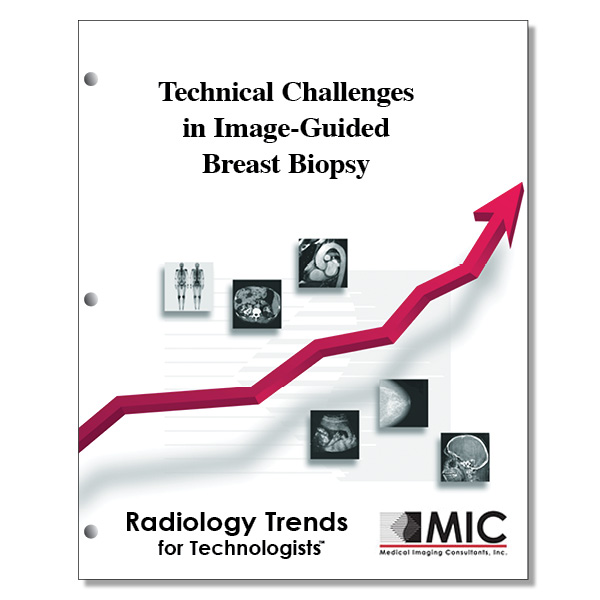

Technical Challenges in Image-Guided Breast Biopsy
Strategies and procedural modifications are offered to aid in successful completion of breast biopsy when patient factors or lesion factors might otherwise pose technical challenges.
Course ID: Q00538 Category: Radiology Trends for Technologists Modalities: Mammography, MRI, Sonography2.0 |
Satisfaction Guarantee |
$24.00
- Targeted CE
- Outline
- Objectives
Targeted CE per ARRT’s Discipline, Category, and Subcategory classification for enrollments starting after March 18, 2024:
Breast Sonography: 2.00
Procedures: 2.00
Breast Interventions: 2.00
Mammography: 2.00
Procedures: 2.00
Mammographic Positioning, Special Needs, and Imaging Procedures: 2.00
Magnetic Resonance Imaging: 2.00
Procedures: 2.00
Body: 2.00
Registered Radiologist Assistant: 2.00
Procedures: 2.00
Thoracic Section: 2.00
Sonography: 2.00
Procedures: 2.00
Superficial Structures and Other Sonographic Procedures: 2.00
Outline
- Introduction
- Planning Image-guided Breast Biopsy
- Technical Challenges: Patient Factors
- Patient Comorbidities
- Anticoagulation
- Thin Breast
- Brest Implants
- Technical Challenges: Lesion Factors
- Conspicuity of Target
- Location of Target
- Posterior or Deep Target
- Superficial Target
- Axillary Target
- Subareolar Target
- Multimodality Target Correlation
- Cancellation of Image-guided Breast Biopsy
- Conclusion
Objectives
Upon completion of this course, students will:
- compare open surgical breast biopsy to image-guided breast biopsy
- list the types of image-guided breast biopsies that can be performed
- list the basic steps involved with stereotactic breast biopsy
- state the patient position for stereotactic breast biopsy
- state the patient position for US-guided breast biopsy
- describe the patient’s arm position for US-guided breast biopsy
- recall the most expensive modality for breast biopsy
- explain the importance of pre-procedural review of diagnostic images and clinical information
- recall the best stereotactic approach for targets seen in the craniocaudal projection
- list the reasons making US the most commonly used modality for breast biopsy
- match the imaging modality that must be used for targets seen only at MR breast imaging
- list the factors that may limit a patient’s ability to have an image-guided breast biopsy
- recall the minimum breast thickness for standard needle use in stereotactic breast biopsy
- recall the minimum breast thickness for a shortened sampling chamber needle in MR-guided breast biopsy
- choose the best breast specimen option for thin-breasted women
- list the options utilized during stereotactic breast biopsy that can help thicken the breast
- state the position of the sampling chamber for vacuum-assisted needle biopsy
- recall the techniques used to ensure an adequate vacuum seal for safe needle-guided biopsy
- explain the necessary location for breast implants to avoid rupture
- list the tools used to help identify small or subtle targets before breast biopsy
- list landmarks used in MR breast imaging to help identify the intended target for biopsy
- state the important success factors when targeting a lesion in the posterior breast when using prone stereotactic-guided biopsy
- choose the technique used to better access lesions in the posterior breast and axillary tail
- list the advantages of a stereotactic breast biopsy “fitting”
- recall the technique used in MR breast biopsy for accessing a posterior lesion
- state the entry site for US breast biopsy of posterior targets
- choose the needle device best suited for superficial breast targets being accessed via US guidance
- state the sampling chamber size required for stereotactic or MR guided biopsy of a superficial breast target
- list the structures to be avoided in the axilla during axillary breast biopsy
- compare cost and comfort of US-guided biopsy to MR-guided biopsy
- state the percent of accuracy of accessing sub-areolar calcifications when utilizing a high-frequency US probe
- list imaging characteristics of lesions found at MR imaging that increase the likelihood of identifying a US correlate
- describe follow up needed for nonspecific benign concordant pathology results when the MR imaging lesion was biopsied under US guidance
- state the MR sequence that helps increase confidence in the correlation of lesions initially identified at MR imaging and biopsied with stereotactic or US guidance
- state the cancellation rate for stereotactic-guided breast biopsy
- name the most common reason for stereotactic-guided breast biopsy cancellation
- state the options when stereotactic-guided breast biopsy cannot be performed
- state the overall cancellation rate for MR imaging-guided biopsy for lesion non-identification at the time of biopsy
- recall the most common MR imaging finding that is not identified at the time of MR imaging-guided biopsy
- state alternate techniques to help visualize targets not previously enhanced at attempted MR imaging-guided biopsy
